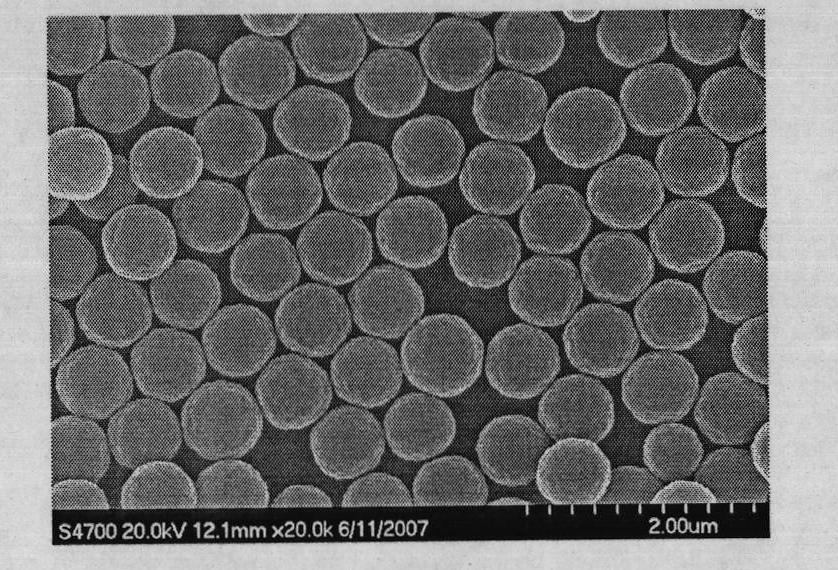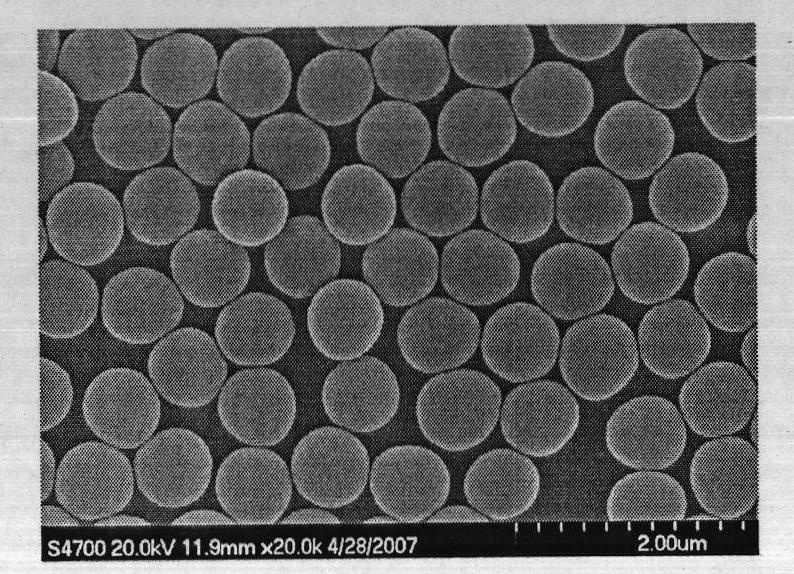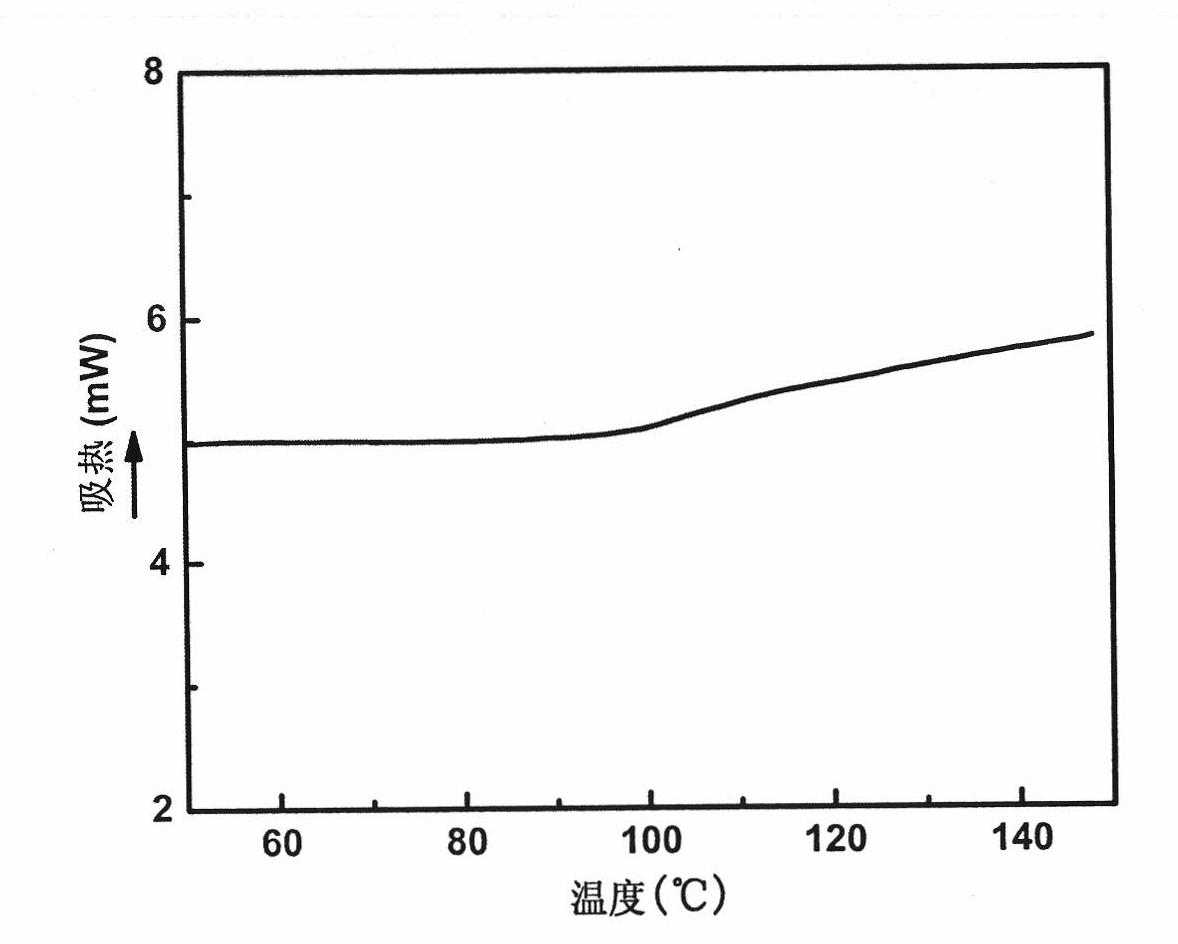Method for preparing highly crosslinked polystyrene microsphere by stable dispersion polymerization of charge
A polystyrene microsphere and dispersion polymerization technology, which is applied in the field of polymer microsphere materials, can solve the problems of low crosslinking degree of microspheres, and achieve the effect of simple and easy preparation method, fast reaction speed and increased crosslinking degree
- Summary
- Abstract
- Description
- Claims
- Application Information
AI Technical Summary
Problems solved by technology
Method used
Image
Examples
Embodiment 1
[0024] Styrene (St) 5.0ml, crosslinking agent divinylbenzene 0.02265g, initiator azobisisobutyronitrile 0.0453g, stabilizer methacryloyloxyethyltrimethylammonium chloride 0.0906g, methanol 40ml , 10ml of deionized water was added into a 250ml three-neck flask, then it was placed in a water bath, a condensate pipe was installed and the mechanical stirring was turned on (rotating speed was 200rpm). Turn on the heating device, keep the reaction temperature at 75°C, and react for 8 hours. After the reaction, the polystyrene microspheres were separated from the emulsion by centrifugation (3500 rpm, 30 min), and then placed in a vacuum oven at 50° C. for drying. Before test characterization, the particles were washed three times with methanol to remove oligomers adsorbed on the surface of the microspheres.
[0025] Gained polystyrene microsphere particle size is 650nm, and particle size distribution coefficient is 5.63%, and productive rate is 75.48%, and gel content is 35.25%, and...
Embodiment 2
[0027] St 7.5ml, crosslinking agent divinylbenzene 0.1812g, initiator azobisisobutyronitrile 0.0906g, stabilizer methacryloyloxyethyltrimethylammonium chloride 0.0453g, methanol 42.5ml, deionized Add 7.5ml of water into a 250ml three-neck flask, then place it in a water bath, install a condensate pipe and turn on mechanical stirring (rotating speed is 200rpm). Turn on the heating device, keep the reaction temperature at 75°C, and react for 8 hours. After the reaction, the polystyrene microspheres were separated from the emulsion by centrifugation (3500 rpm, 30 min), and then placed in a vacuum oven at 50° C. for drying. Before test characterization, the particles were washed three times with methanol to remove oligomers adsorbed on the surface of the microspheres.
[0028] Gained polystyrene microsphere particle size is 700nm, and particle size distribution coefficient is 2.99%, and productive rate is 75.15%, and gel content is 84.16%, and glass transition temperature is 108....
Embodiment 3
[0030] St 5.0ml, crosslinking agent divinylbenzene 0.3624g, initiator azobisisobutyronitrile 0.0906g, stabilizer methacryloyloxyethyltrimethylammonium chloride 0.01133g, methanol 40ml, deionized water 10ml was added into a 250ml three-neck flask, then it was placed in a water bath, a condensate pipe was installed and the mechanical stirring was turned on (rotating speed was 200rpm). Turn on the heating device, keep the reaction temperature at 75°C, and react for 8 hours. After the reaction, the polystyrene microspheres were separated from the emulsion by centrifugation (3500 rpm, 30 min), and then placed in a vacuum oven at 50° C. for drying. Before test characterization, the particles were washed three times with methanol to remove oligomers adsorbed on the surface of the microspheres.
[0031]The particle size of the obtained polystyrene microspheres is 740nm, the particle size distribution coefficient is 2.45%, the yield rate is 70.15%, the gel content is 85.84%, the DSC c...
PUM
| Property | Measurement | Unit |
|---|---|---|
| particle diameter | aaaaa | aaaaa |
| particle diameter | aaaaa | aaaaa |
| glass transition temperature | aaaaa | aaaaa |
Abstract
Description
Claims
Application Information
 Login to View More
Login to View More - R&D
- Intellectual Property
- Life Sciences
- Materials
- Tech Scout
- Unparalleled Data Quality
- Higher Quality Content
- 60% Fewer Hallucinations
Browse by: Latest US Patents, China's latest patents, Technical Efficacy Thesaurus, Application Domain, Technology Topic, Popular Technical Reports.
© 2025 PatSnap. All rights reserved.Legal|Privacy policy|Modern Slavery Act Transparency Statement|Sitemap|About US| Contact US: help@patsnap.com



